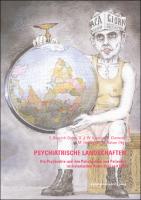Psychiatrische landschaften
Die Psychiatrie und ihre Patientinnen und Patienten im historischen Raum Tirol seit 1830
Contributor(s)
Dietrich-Daum, E. (editor)
Kuprian, H. J. W. (editor)
Clementi, S. (editor)
Heidegger, M. (editor)
Ralser, M. (editor)
Collection
AG UniversitätsverlageLanguage
GermanAbstract
People with mental impairments are confronted with many prejudices. Some of these prejudices are related to the fact that the former places of their treatment, the psychiatric asylums, wherever they were established, always had the dual function to not only provide shelter for the 'sick' but also to admonish the 'healthy'. This is also the case in the geographical area of the historical Tyrol (province of Tyrol, autonomous provinces of Bolzano-Alto Adige and Trento-Trentino). Threats like "You are going to Hall" or "to Pergine" were and are part of the common language repertoire. In spite of this embedding in everyday life, knowledge of the history and present of psychiatry and its patients is comparatively low. The eventful and often interwoven history of the three historical parts of the country, also in the field of psychiatric care, begins in the founding year of the k. k. Irrenanstalt Hall in Tyrol (1830), continues with the opening of the mental hospital in Pergine/Trentino (1882) and the neurological-psychiatric clinic in Innsbruck (1891) and reaches its tragic climax during the time of National Socialism and the Second World War. After years of neglect and forgetting, it is the Italian reform psychiatry of the late 1970s (Basaglia's law) and the Austrian psychiatric reform of the early 1990s that have decisively changed the psychiatric landscape of this region. 32 short articles highlight different aspects of the shared and different ways of psychiatric provision in the historical region of Tyrol and its transformations from the 19th century to the present for an interested audience. - Menschen mit psychischen Beeinträchtigungen sehen sich mit vielen Vorurteilen konfrontiert. Einige dieser Vorurteile hängen damit zusammen, dass die frühen Orte ihrer Behandlung, die psychiatrischen Anstalten, wo immer sie eingerichtet wurden, stets die Funktion zu erfüllen hatten, nicht nur Herberge für die ‚Kranken’, sondern auch Mahnung für die ‚Gesunden’ zu sein. Das gilt auch für den geografischen Raum des historischen Tirol (Bundesland Tirol, Autonome Provinzen Bozen-Südtirol und Trient-Trentino). Drohungen wie „Du kommst nach Hall“ oder „nach Pergine“ waren und sind Teil des sprachlichen Standardrepertoires. Trotz dieser alltagsweltlichen Verankerung ist das Wissen um Geschichte und Gegenwart der Psychiatrie und ihrer Patienten und Patientinnen vergleichsweise gering. Die wechselvolle und vielfach auch im Feld der psychiatrischen Versorgung miteinander verwobene Geschichte der drei historischen Landesteile beginnt im Gründungsjahr der k. k. Irrenanstalt Hall in Tirol (1830), setzte sich fort in der Eröffnung der Anstalt in Pergine/Trentino (1882) sowie der Neurologisch-Psychiatrischen Klinik in Innsbruck (1891) und findet in der Zeit des Nationalsozialismus und des Zweiten Weltkriegs ihren tragischen Höhepunkt. Nach Jahren des Verdrängens und Vergessens sind es die italienische Reformpsychiatrie der späten 1970er Jahre (‚Basaglia’-Gesetz) und die österreichischen Psychiatriereform der frühen 1990er Jahre, welche die psychiatrische Landschaft dieses Raumes entscheidend verändern. In 32 kurzen Beiträgen werden verschiedene Aspekte der gemeinsamen und unterschiedlichen Wege der psychiatrischen Versorgung im historischen Raum Tirol undihre Transformationen vom 19. Jahrhundert bis in die Gegenwart für ein allgemein interessiertes Leserpublikum aufgezeigt.
Keywords
Tyrol; South Tyrol; Trentino; Psychiatry; Mental Hospital; Tirol; Südtirol; Psychiatrie; Psychiatrische KlinikPublisher
innsbruck university pressPublisher website
https://www.uibk.ac.at/iupPublication date and place
Innsbruck, 2011Classification
Psychiatry
Clinical psychology


 Download
Download Web Shop
Web Shop